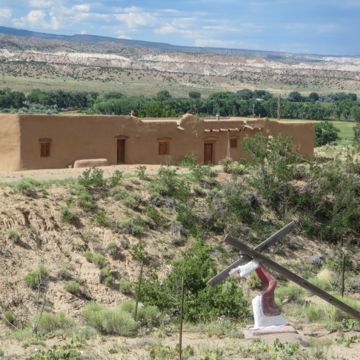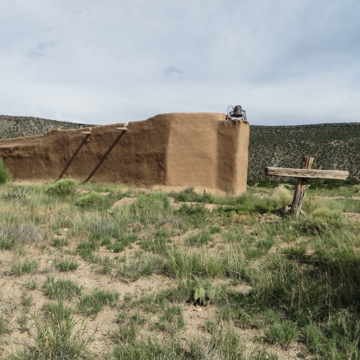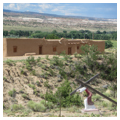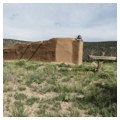The well-preserved East Penitente Morada (meeting house) in Abiquiú is probably the oldest extant example of a culturally unique vernacular building type whose construction dates to New Mexico’s Mexican Period.
The Penitente Brotherhood is a lay Catholic group known primarily for its penitential rituals that originated during the colonization of New Mexico by Spain in the late sixteenth and the seventeenth centuries. According to historical records, in 1598 Spanish colonists observed Holy Thursday with a variety of penances, including self-flagellation and walking barefoot. These practices were tolerated until the nineteenth century, when hostility towards bodily mortification grew within the Catholic Church. Following Mexico’s independence from Spain in 1821, the Penitentes began to construct their own sanctuaries after the Church implemented rules that threatened their practices.
Settled in 1740, Abiquiú was the third largest Hispanic community in New Mexico at the start of the nineteenth century. It was also remote from the concentration of Spanish villages along the Rio Grande Valley. Abiquiú’s size and isolation provided it with both the financial resources and the freedom necessary to construct the East Penitente Morada soon after the Archdiocese in Santa Fe began to repress the penitential tradition.
Abiquiú has two moradas, the East Penitente Morada, located three hundred meters to the east of Santo Tomás Mission, and the South Penitente Morada, located four hundred meters to the south. Moradas are usually part of a larger religious landscape that also includes a Way of the Cross ( Via Crucis) , a cemetery, and the parish church. The cemetery lies between the moradas and is used as the “Calvary” or crucifixion site on the Via Crucis.
The East Morada is linear in plan and measures approximately 95 x 16.5 feet. There are two doors and three windows, all on the south side, leaving the remaining walls blank. A trapezoidal apse with a stone belfry is located on the west end and three large crosses stand near the building’s southeast side. Its interior contains a storeroom, a sacristy, and a chapel, each of which is commonly found in moradas throughout northern New Mexico and southern Colorado. Like most of the historic buildings in Abiquiú, the East Penitente Morada is constructed from adobe brick and has a flat roof supported by vigas. From the exterior, the building is almost indistinguishable from domestic structures, except for such telltale features as the walls without windows, a belfry, a large cross, and a nearby path that serves as the Via Crucis during Holy Week.
Though a morada could be used for such secular activities as political meetings, its primary purpose was—and is—to serve the religious practices of the Penitente Brotherhood. These practices reach a peak during Holy Week, when members of the brotherhood spend most of their time at the morada, where they eat, sleep, pray, and engage in acts of self-mortification. On Good Friday, the brotherhood reenacts the Passion of Christ, culminating in the crucifixion of one of the members (reportedly with real nails in the past, now simulated with ropes). Las Tinieblas, the ritual of "the darkenings," takes place inside the morada in the evening. The lights are dimmed, and a period of prayer is succeeded by a clamor of rattles, wooden blocks, metal sheets, ratchets, chains, and other items to mark the moment when Jesus Christ died on the cross. The poet Alice Corbin Henderson attended Las Tinieblas in Abiquiú in the early 1930s and her book, Brothers of the Light, provides a moving account of the ceremony.
In the mid-1960s, historian Richard E. Ahlborn was given permission to photograph and document the East Penitente Morada, and his report, The Penitente Moradas of Abiquiú, offers an unparalleled description of the interior of a morada. Each of the rooms has a dirt floor and whitewashed, plaster walls. At the time of Ahlborn’s visit, the storeroom, located on the east end, included a tub for washing off blood after penance, a processional cross, a ladder, two percussion rifles, the bell that was formerly housed in the belfry, and a wooden cart, which is traditionally used to carry a statue of death ( La Muerte) during processions. The sacristy had benches and two corner fireplaces, along with a storage chest that Ahlborn was told contained cooking and eating utensils, as well as ceremonial paraphernalia. The chapel had a raised altar, set off by a curtain, and was decorated with religious images ( santos) in the form of sculptures ( bultos) and flat-paneled paintings ( retablos). Depictions of the Crucifixion behind the altar were accompanied in front by small, commercially made crucifixes and other religious objects. The walls were hung with religious prints in tinwork frames, and the furniture included two candelabra and several benches. Ahlborn noted that the items in the chapel were similar to those found in eighteenth- and nineteenth-century churches in New Mexico.
The grounds and interior of the East Penitente Morada are off-limits to visitors, but the building can be viewed from Palvadera Road and Rio Arriba County 188.
References
Ahlborn, Richard Eugene. The Penitente Moradas of Abiquiú. Washington, D.C.: Smithsonian Institution Press, 1986.
Boyd, E. “Application for Registration, New Mexico State Register of Cultural Properties: East Morada, Abiquiu, New Mexico.” Listed July 31, 1970, State Register No. 196. Original on file at the New Mexico State Historic Preservation Department, Santa Fe, New Mexico.
Bunting, Bainbridge, Thomas R. Lyons, and Margil Lyons. “Penitente Brotherhood Moradas and their Architecture.” In Hispanic Arts and Ethnohistory in the Southwest: New Papers Inspired by the Work of E. Boyd, edited by Marta Weigle with Claudia Larcombe and Samuel Larcombe, 34-47. Santa Fe: Ancient City Press, 1983.
Henderson, Alice Corbin. Brothers of Light: The Penitentes of the Southwest. New York: Harcourt, Brace and Company, 1937.
Lummis, Charles. The Land of Poco Tiempo. New York: Charles Scribner’s Sons, 1893.
Sze, Corinne. Religious Properties of New Mexico. National Register Thematic Nomination. Santa Fe: New Mexico State Historic Preservation Department, 1995.
Weigle, Marta. The Penitentes of the Southwest. Santa Fe: Ancient City Press, 1970.




